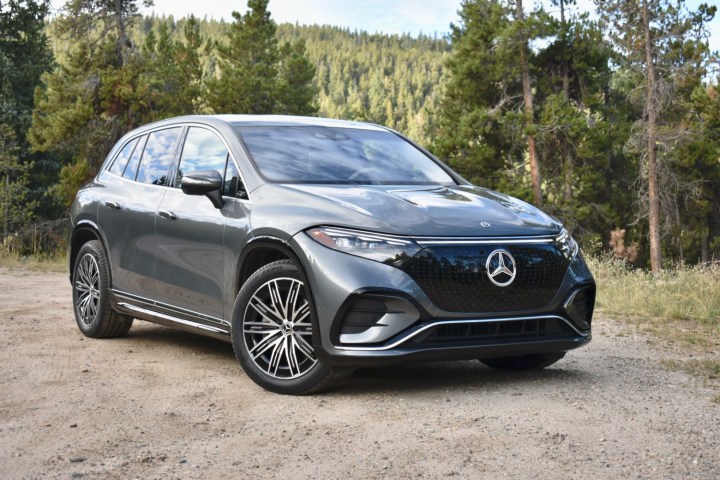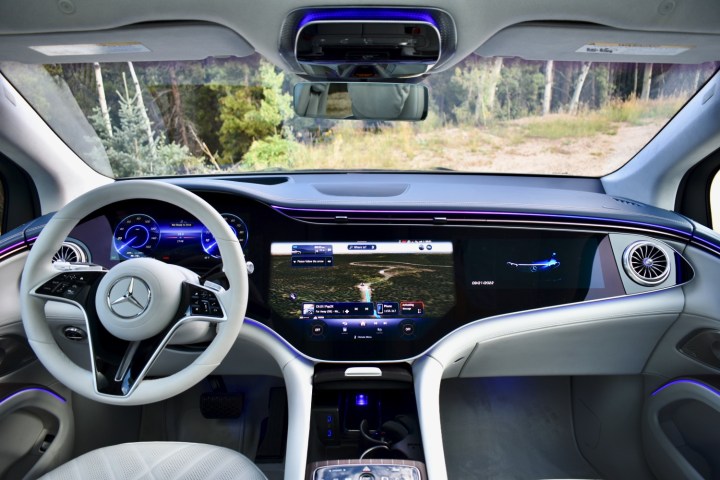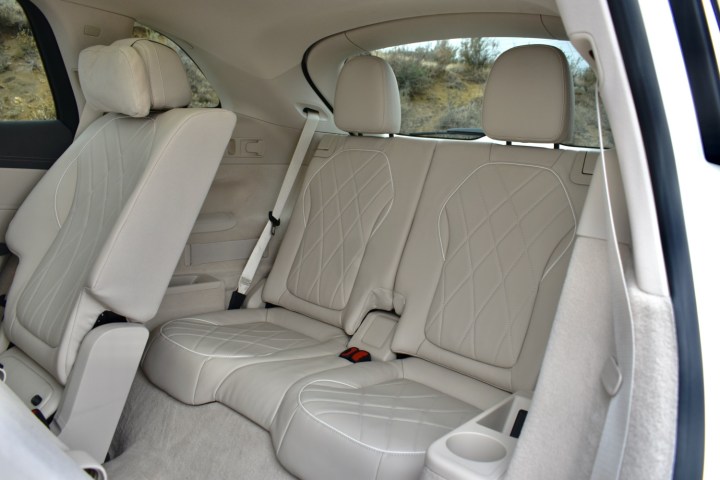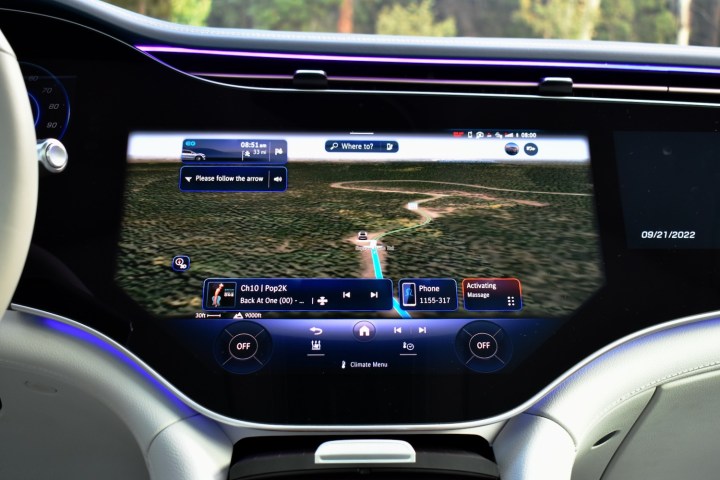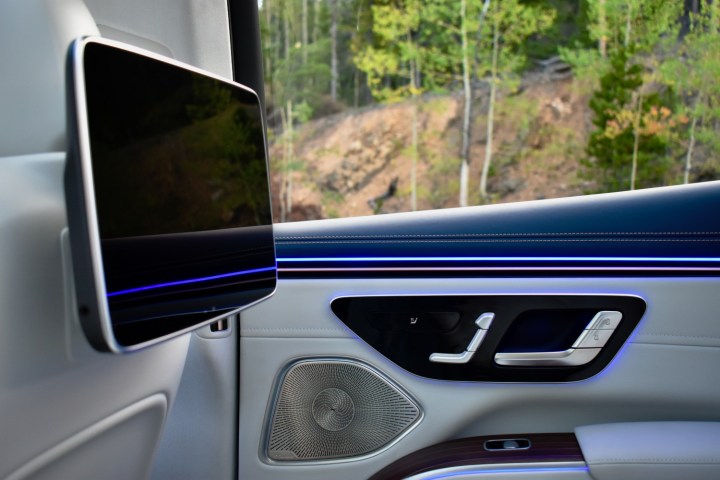Mercedes-Benz is continuing to expand its EV lineup, this time with a model aimed at (wealthy) families.
As the name states, the 2023 Mercedes-Benz EQS SUV is an SUV derivative of the EQS sedan. With the EQS sedan positioned as the electric analog to the Mercedes S-Class, the EQS SUV is the electric version of the GLS-Class. And like that vehicle, the EQS SUV is available with up to seven seats across three rows.
That makes the EQS SUV an important vehicle not just for Mercedes, but for the cause of EV adoption in general. While the Tesla Model X and Rivian R1S also offer three rows for family-hauling duty, there’s a lot more room in the market for another entry. Given the popularity of equivalent gasoline luxury SUVs like the GLS, Land Rover Range Rover, and Cadillac Escalade, the EQS SUV arrives not a moment too soon.
The EQS SUV is scheduled to reach U.S. dealerships this fall in three guises. The base rear-wheel-drive EQS 450+ starts at $105,550 with destination, while the all-wheel drive EQS 450 4Matic and EQS 580 4Matic start at $108,550 and $127,100, respectively. Although it will be built in Alabama, the EQS SUV won’t qualify for the revised federal EV tax credit because it exceeds the $80,000 price cap for SUVs.
Design and interior
A defining feature of Mercedes’ EQ lineup is aerodynamic bodywork aimed at maximizing range. The typical SUV is not aerodynamically ideal, but Mercedes managed to achieve an impressively low drag coefficient for an SUV — at 0.26, it’s close to the Toyota Prius. But function clearly took precedence over form. Mercedes deserves credit for not going in the polarizing direction BMW did with its two-row iX SUV, but the EQS SUV looks like a melting scoop of ice cream.
More disappointing is the third row, which should be the EQS SUV’s defining feature, but seems more like a useless afterthought. Adults will find it difficult to insert themselves into the third-row seats, let alone tolerate riding in them. As in most three-row vehicles, the rear seats also pretty much eliminate cargo space. And if you want to fold them down to create more cargo room, you’ll have to do it manually as Mercedes didn’t include a power-folding system — a bit disappointing for a six-figure car. The EQS SUV also lacks a frunk; like the EQS sedan, the hood is sealed.
The EQS SUV looks like a melting scoop of ice cream.
Installing a third row in an EV doesn’t have to be a problem. The Rivian R1S is close in overall size to the EQS SUV, but adults will actually be able to fit in its third row. And keep in mind the R1S has a shorter wheelbase than the EQS. Take the third row out of the equation, and the EQS SUV doesn’t feel more spacious than the two-row iX or Cadillac Lyriq. While the second row can be classed up with entertainment screens and pillows for the headrests, it also didn’t feel as comfortable as we’ve come to expect in high-end gasoline luxury SUVs.
The interior does look nice, though, largely repeating the design of the EQS sedan. The dashboard is a flat expanse sprouting screens and air vents, a look echoed in seat controls that stand proud of the door panels. Mercedes also chose some interesting color options, pairing blue trim on the upper door panels with white leather upholstery, for example.
Tech, infotainment, and driver assist
The EQS SUV gets a version of the Mercedes-Benz User Experience (MBUX) infotainment system used in the automaker’s other models. A 12.8-inch portrait-oriented touchscreen and 12.3-inch digital instrument cluster are standard on the EQS 450+ and 450 4Matic models, while the more elaborate Hyperscreen display from the EQS sedan is optional on those models and standard on the range-topping EQS 580 4Matic. It consists of a 12.3-inch digital instrument cluster, 17.7-inch central touchscreen, and 12.3-inch front-passenger touchscreen all under one curved glass surface, combining to form 56 inches of screen space.
The Hyperscreen is more than just an obscenely large display. It also addresses infotainment fundamentals with eye-catching graphics and responsive touchpoints, as well as offering the same excellent voice recognition as other Mercedes models. Mercedes’ “Zero Layer” concept also lays out most functions as individual tiles across one screen, so you don’t have to navigate to different menus to find them. These features also impressed us in the EQE and EQS sedans, but the Hyperscreen might make more sense in the family-oriented EQS SUV, where a parent can make use of the front-passenger screen while serving as co-pilot on road trips.
The Hyperscreen is more than just an obscenely large display.
Other standard tech features include wireless Apple CarPlay and Android Auto connectivity, navigation with an augmented-reality feature that projects arrows to show turns, a fingerprint sensor for activating individual driver profiles, and a 15-speaker Burmester surround-sound system with Dolby Atmos tech. Wireless smartphone charging and six USB ports are included as well, while a head-up display and automatic toll transponder are optional.
Because it’s positioned as the flagship of the EQ SUV lineup, the EQS SUV gets the normally optional Driver Assistance Package as standard equipment. This includes Distronic adaptive cruise control (with route-based speed adaptation and stop-and-go functionality), automatic emergency braking, forward collision warning, lane-keep assist, and Pre-Safe Plus with Pre-Safe Sound and Pre-Safe Impulse Side. The Pre-Safe features are designed to minimize the chance of injury when a crash is deemed imminent. Pre-Safe Impulse Side inflates seat bolsters to move occupants away from the doors, while Pre-Safe Sound projects a noise designed to trigger a protective reflex in the human ear to prevent hearing loss.
Driving experience
The base EQS 450 version has a single motor sending 355 horsepower and 419 pound-feet of torque to its rear wheels, enabling zero to 60 mph in a Mercedes-estimated 6.5 seconds. The EQS 450 4Matic model adds a second motor powering the front wheels, upping torque output to 590 lb-ft and lowering the zero to 60 mph time to 5.8 seconds.
The top EQS 580 4Matic also gets dual-motor all-wheel drive, but with a significant boost in power to 536 hp and 633 lb-ft of torque. This version does zero to 60 mph in a claimed 4.5 seconds, while all three versions have an electronically limited top speed of 130 mph. They also share the same 108.4-kilowatt-hour battery pack.
We drove all three versions on a loop of highways and backroads around Denver, Colorado, and didn’t find much subjective difference in real-world performance. The EQS 580 4Matic definitely felt as quick as the Mercedes-quoted zero to 60 mph time would suggest, but the two 450 versions weren’t exactly sluggish.
The EQS SUV had the excellent ride quality one should expect of a Mercedes.
The EQS SUV had the excellent ride quality one should expect of a Mercedes on the highway, and its standard rear-axle steering made maneuvering in tight spaces easier, but the EQS SUV wasn’t exactly a joy to drive on twisty roads. We weren’t expecting this luxurious Mercedes to be a sports car, but it leaned so much in corners that we needed to engage Sport mode just to provide a minimal level of composure. Other electric luxury SUVs like the BMW iX, Cadillac Lyriq, and Rivian R1S have a better balance between ride quality and handling.
While it uses the same regenerative braking system as the EQS sedan, we notice more issues in this application. Mercedes generally doesn’t support one-pedal driving, where an EV relies primarily on regenerative braking and lets the driver avoid using the brake pedal most of the time. But we found ourselves mashing the pedal even more in the EQS SUV than in other Mercedes EQ models. And the pedal itself felt hard and had little travel, making it difficult to gauge how much pressure was needed to get adequate deceleration. It wasn’t exactly a confidence-inspiring experience.
Mercedes was also keen to show off the EQS SUV’s off-road capability, taking us on a short rock-strewn course that briefly had us driving with a wheel off the ground. The EQS SUV didn’t get stuck, but we wouldn’t advise trying this at home. Because while Mercedes provides an off-road drive mode, air suspension that can be raised to improve ground clearance, and a camera system that shows a virtual view of the front wheels, it didn’t provide skid plates to protect the battery pack or an all-terrain tire option.
Range, charging, and safety
Official range ratings haven’t been published yet, but Mercedes estimates a maximum 305 miles of range for the single-motor rear-wheel drive EQS 450+ and 285 miles for the dual-motor all-wheel drive EQS 450 4Matic and EQS 580 4Matic models. Those are impressive figures for such a large vehicle, but still fall short of the 332-mile range of the base Tesla Model X.
DC fast charging at 200 kilowatts enables a 10% to 80% charge in 31 minutes, while a Level 2 AC charger can take the battery from zero to 100% in 12.5 hours, according to Mercedes. As with other EQ models, Mercedes is offering unlimited free 30-minute DC fast-charging sessions at Electrify America locations for two years after activating a Mercedes Me account.
The Insurance Institute for Highway Safety (IIHS) and National Highway Traffic Safety Administration (NHTSA) haven’t released crash-test ratings for this new model.
Like other Mercedes models, the EQS SUV comes with a four-year, 50,000-mile, new-vehicle warranty. It also gets the same 10-year, 155,000-mile, battery warranty as other Mercedes EVs.
How DT would configure this car
In addition to the EQS 450+, EQS 450 4Matic, and EQS 580 4Matic models, buyers will have three trim levels — Premium, Exclusive, and Pinnacle — to choose from. Our ideal configuration would be an EQS 450 4Matic in the Exclusive trim level.
The base Premium trim level comes well equipped with features like leather upholstery, heated and ventilated front seats, Burmester audio system with Dolby Atmos, Driver Assistance Package, and Parking Package with surround-view camera system. That takes care of most of the notable tech features, but we would consider upgrading to the Exclusive trim level, which adds a head-up display, as well as some useful convenience features like four-zone climate control and massaging front seats. The Hyperscreen is also a standalone option that adds a serious wow factor.
We would stick with the 450 4Matic rather than upgrading to the 580 4Matic because the latter’s extra power didn’t make enough of a subjective difference in the real world to justify its price premium. The base price for the EQS SUV 450 4Matic Exclusive is $112,800 with destination, plus the cost of the Hyperscreen, which Mercedes hadn’t priced out at the time of publication.
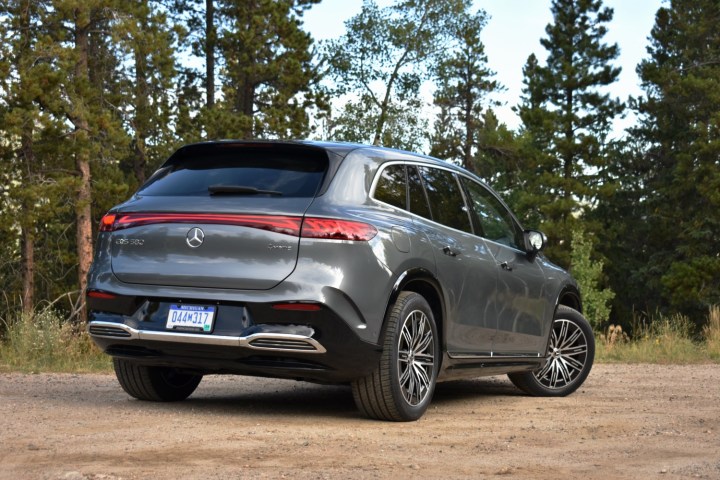
At that price, the EQS SUV really makes sense only within Mercedes’ internal hierarchy, where it slots above the upcoming EQE SUV and the EQB in size and level of standard equipment. Loyal Mercedes fans might also appreciate the option of the SUV body style for the EQS.
Beyond that, it doesn’t make sense to pay tens of thousands more over a BMW iX or Cadillac Lyriq, just for a cramped third row, or to pay a similar premium over the three-row Rivian R1S. Availability might be a factor, as supplies of the Cadillac and Rivian are fairly tight right now, but it’s still hard to think of anything that justifies the Mercedes’ price premium over other luxury electric SUVs.
Editors’ Recommendations


